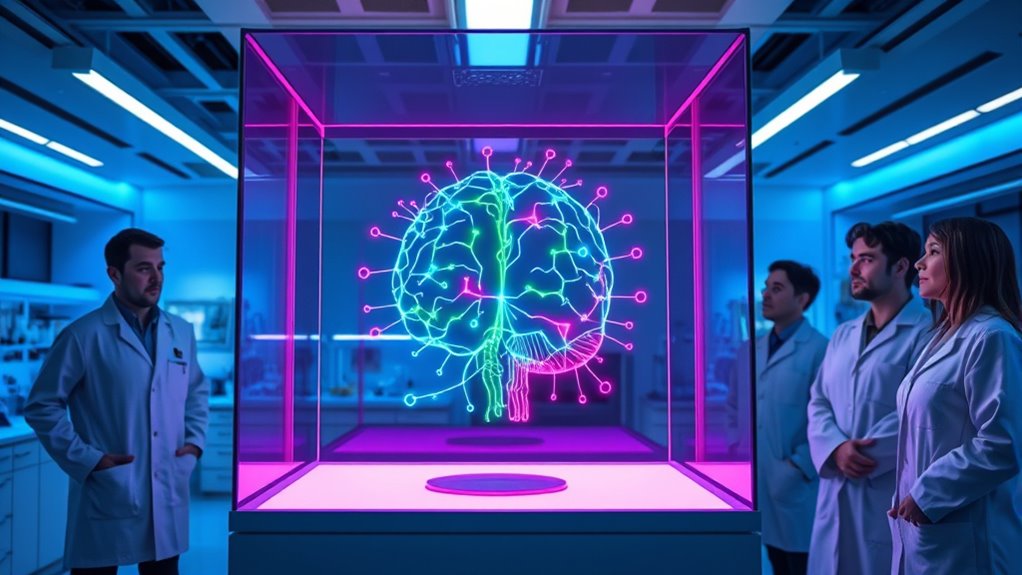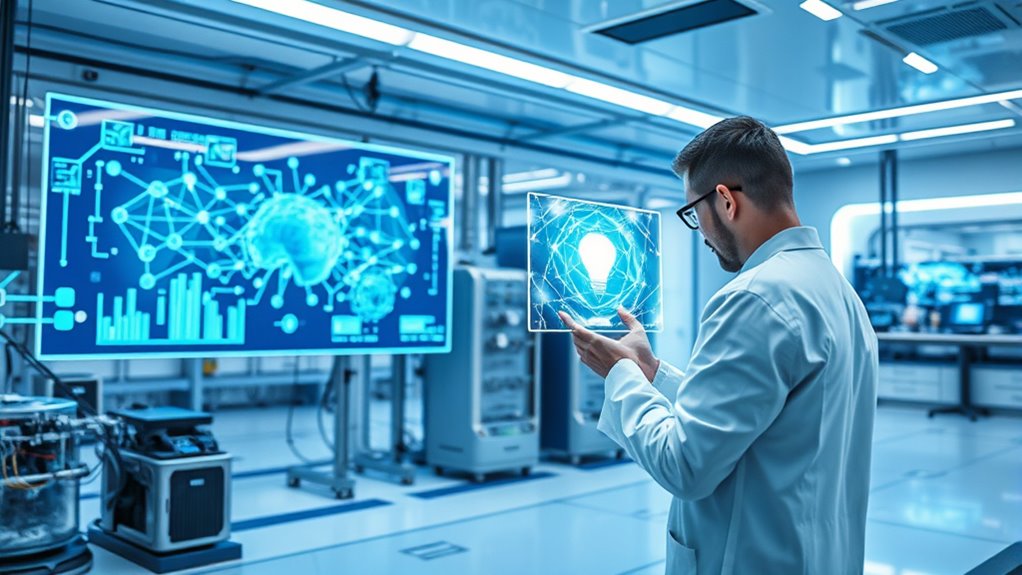OpenAI has launched a next-generation AI model that greatly improves reasoning abilities, advancing machine understanding and processing. You’ll see smarter responses, better problem-solving skills, and more nuanced interpretations. This model emphasizes responsible deployment, with built-in safety and ethical principles to minimize biases. Driven by innovative training methods and architecture, it’s designed to serve users more fairly and accurately. If you want to learn how these improvements could impact AI’s future, keep exploring further details.
Key Takeaways
- OpenAI has launched a next-generation AI model featuring enhanced reasoning capabilities.
- The new model emphasizes responsible development, aligning AI behavior with human values.
- Innovations in training techniques and architecture improve understanding of complex concepts.
- Rigorous safety and validation measures ensure ethical deployment and mitigate biases.
- The model’s advanced reasoning supports solving complex problems and interpreting subtle nuances.

OpenAI has revealed its latest breakthrough in artificial intelligence with the launch of its next-generation AI model. This new development promises to revolutionize how machines understand and process information, especially with its enhanced reasoning capabilities. As you explore this model, it’s essential to contemplate the importance of AI ethics, which guide responsible development and deployment. OpenAI has prioritized creating AI that aligns with human values, ensuring that as the model becomes more powerful, it also remains safe and beneficial. This focus on ethics influences every stage of model training, from dataset selection to fine-tuning, minimizing biases and preventing harmful outputs.
OpenAI’s latest AI model emphasizes ethics, safety, and human alignment throughout development and training processes.
When you plunge into the training process of this next-gen AI, you’ll notice that OpenAI has employed innovative techniques to improve both efficiency and accuracy. Model training for such advanced systems involves vast amounts of data, carefully curated to encompass diverse perspectives and knowledge domains. This not only boosts the AI’s ability to reason but also helps it develop a more nuanced understanding of complex concepts. During training, OpenAI emphasizes transparency, enabling you to better comprehend how the model learns and why it makes certain decisions. This transparency is key to building trust, especially as AI models become more integrated into daily tasks and decision-making processes.
Furthermore, OpenAI’s approach to model training incorporates rigorous safety measures to prevent unintended behaviors. You’ll find that the training process includes multiple layers of testing and validation, designed to identify and mitigate potential issues before deployment. This proactive stance on safety reflects a broader commitment to AI ethics, ensuring that models serve users fairly and responsibly. As a result, the AI can handle sensitive topics more carefully and respond with greater contextual awareness. Additionally, advances in predictive modeling contribute to the AI’s ability to anticipate and adapt to complex scenarios, further enhancing its reasoning skills.
The improved reasoning abilities of this next-gen AI stem from advancements in both architecture and training methodology. You’ll notice that it can solve complex problems, draw logical connections, and interpret subtle nuances more effectively than previous models. These enhancements are a direct result of meticulous training processes that emphasize not just data ingestion but also the refinement of reasoning skills. OpenAI’s dedication to ethical principles during this phase guarantees that the model’s reasoning aligns with human expectations and values, minimizing risks associated with misinterpretation or bias.
Frequently Asked Questions
How Does the New AI Model Compare to Previous Versions?
You’ll notice that the new AI model surpasses previous versions in model accuracy and reasoning complexity. It’s better at understanding nuanced questions and providing more precise, relevant responses. You’ll find it handles complex reasoning tasks more effectively, making interactions smoother and more reliable. This upgrade means you can trust its insights and solutions more than ever, as it truly advances in both accuracy and cognitive depth compared to earlier models.
What Industries Will Benefit Most From the Updated Model?
Ever wondered which industries will thrive with this new AI? You’ll see healthcare innovation flourish as the model enhances diagnostics and patient care, while financial analysis becomes more precise and insightful. This updated AI’s stronger reasoning abilities mean smarter decision-making and automation, transforming how businesses operate. You’ll find it especially valuable in sectors that rely on complex data, making your work more efficient and impactful.
Are There Any Ethical Concerns With the New AI Capabilities?
You should consider that ethics concerns arise with this new AI’s enhanced capabilities, especially around bias mitigation. While it offers improved reasoning, there’s a risk of unintended bias or misuse. You need to stay vigilant, ensuring responsible deployment and continuous monitoring. Prioritizing transparency and ethical guidelines helps address these concerns, so you can leverage the AI’s benefits while minimizing potential harm and maintaining trust.
How Can Developers Access and Implement This AI Model?
Think of accessing the new AI model as unlocking a powerful toolbox. You, as a developer, can do this through OpenAI’s API integration, which acts like a bridge connecting your app to the AI’s capabilities. OpenAI provides extensive developer resources, including documentation and SDKs, making it straightforward to implement. Just follow the guides, set up your API key, and start harnessing the improved reasoning abilities to enhance your projects.
What Are the Limitations of the Improved Reasoning Abilities?
You should be aware that despite the improved reasoning abilities, the AI still has bias concerns and reasoning gaps. It might unintentionally reinforce stereotypes or produce biased responses, especially in complex or sensitive topics. Additionally, the model can struggle with nuanced reasoning or understanding context fully, which means you need to review its outputs carefully, especially in critical applications, to confirm accuracy and fairness.
Conclusion
So, are you ready to see how this next-gen AI transforms the way you work and think? With its enhanced reasoning abilities, you’ll find solutions faster and smarter than ever before. OpenAI’s latest breakthrough isn’t just about technology—it’s about opening new possibilities for your future. Don’t you want to be part of this exciting leap forward? Embrace the change and discover what this powerful AI can do for you today.









